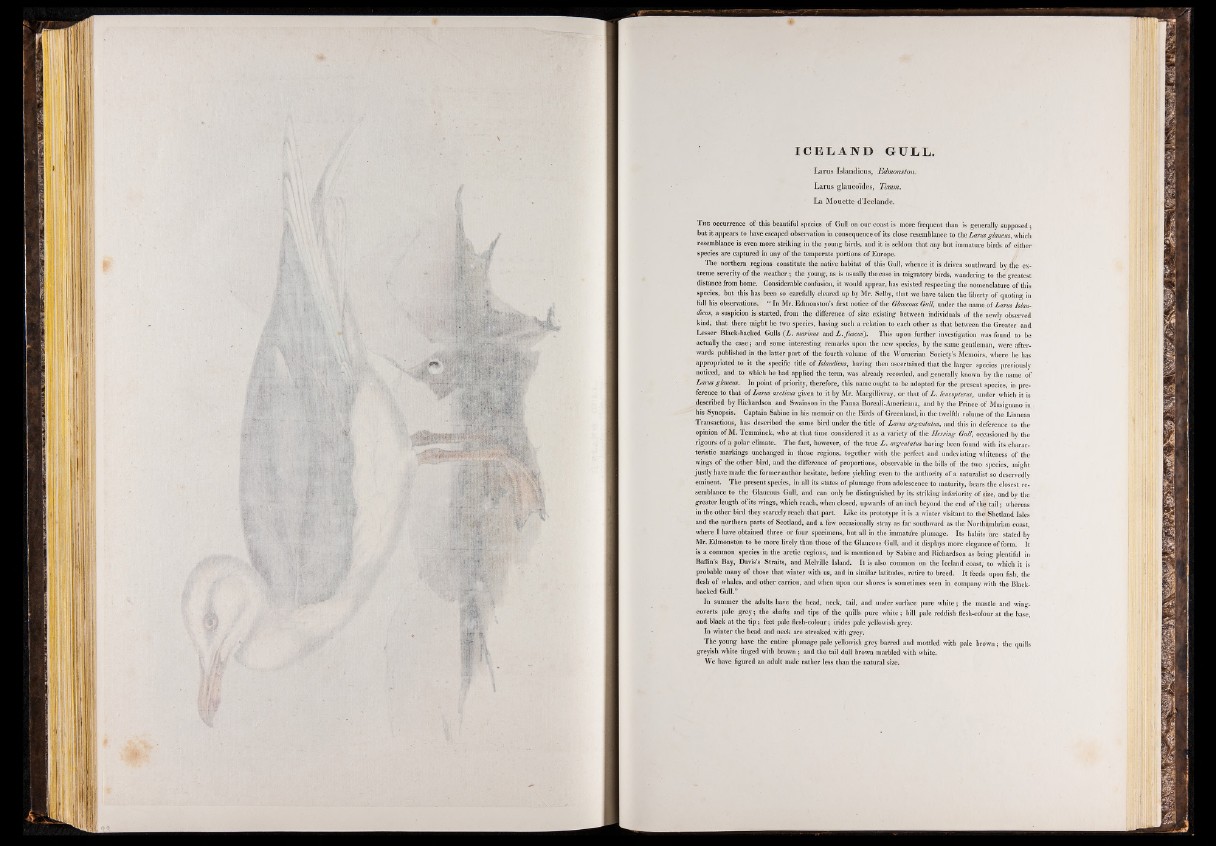
¡¡¡¡Ml
HI'
IC E L A N D GULL.
Larus Islandicus, Edmonston.
Larus glaucoides, Temm.
La Mouette d’Icelande.
T he occurrence of this beautiful species of Gull on our coast is more frequent than is generally supposed;
but it appears to have escaped observation in consequence of its close resemblance to the Larus glaucus, which
resemblance is even more striking in the young birds, and it is seldom that any but immature birds of either
species are captured in any of the temperate portions of Europe.
The northern regions constitute the native habitat of this Gull, whence it is driven southward b y ^ e extreme
severity of the weather; the young, as is usually the case in migratory birds, wandering to the greatest
distance from home. Considerable confusion, it would appear, has existed respecting the nomenclature of this
species, but this has been so carefully cleared up by Mr. Selby, that we have taken the liberty of quoting in
full his observations. “ In Mr. Edmonston’s first notice of the Glaucous Gull, under the name.of Larus Islandicus,
a suspicion is started, from the difference of size existing between individuals of the newly observed
kind, that there might be two species, having such a relation to each other as that between the Greater and
Lesser Black-backed Gulls (\L. marinus and L.fuscus). This upon further investigation was found to be
actually the case; and some interesting remarks upon the new species, by the same gentleman, were afterwards
published in the latter part of the fourth volume of the Wernerian Society’s Memoirs, where he has
appropriated to it the specific title of Islandicus, having then ascertained that the larger species previously
noticed, and to which he had applied the term, was already recorded, and generally known by- the name of
Larus glaucus. In point of priority, therefore, this name ought to be adopted for the present species, in preference
to that of Larus arcticus given to it by Mr. Macgillivray, or that of L . leucopterus, under which it is
described by Richardson and Swainson in the Fauna Boreali-Americana, and by the Prince of Musignano in
his Synopsis. Captain Sabine in his memoir on the Birds of Greenland, in the twelfth volume of the Linnean
Transactions, has described the same bird under the title of Larus argentatus, and this in deference to the
opinion of M. Temminck, who at that time considered it as a variety of the Herring Gull, occasioned bv the
rigours of a polar climate. The fact, however, of the true L . argentatus having been found with its characteristic
markings unchanged in those regions, together with the perfect and undeviating whiteness of the
wings of the other bird, and the difference of proportions, observable in the bills of the two species, might
justly have made the former author hesitate, before yielding even to the authority of a naturalist so deservedly
eminent. The present species, in all its states of plumage from adolescence to maturity, bears the closest resemblance
to the Glaucous Gull, and can only be distinguished by its striking inferiority of §ize, and by the
greater length of its wings, which reach, when closed, upwards of an inch beyond the end of th| tail; whereas
in the other bird they scarcely reach that part. Like its prototype it is a winter visitant to thefShetland Isles
and the northern parts of Scotland, and a few occasionally stray as far southward as the Northumbrian coast,
where I have obtained three or four specimens, but all in the immature plumage. Its habits We stated by
Mr. Edmonston to be more lively than those of the Glaucous Gull, and it displays more elegance of form. It
is a common species in the arctic regions, and is mentioned by Sabine and Richardson as being plentiful in
Baffin’s Bay, Davis’s Straits, and Melville Island. It is also common on the Iceland coast,' to which it is
probable many of those that winter with us, and in similar latitudes, retire to breed. It feeds upon fish, the
flesh of whales, and other carrion, and when upon our shores is sometimes seen in company with the Black-
backed Gull.”
In summer the adults have the head, neck, tail, and under surface pure white; the mantle and wing-
coverts pale grey; the shafts and tips of the quills pure white; bill pale reddish flesh-colour at the base,
and black at the tip; feet pale flesh-colour; irides pale yellowish grey.
In winter the head and neck are streaked with grey.
The young have the entire plumage pale yellowish grey barred and mottled with pale brown; the quills
greyish white tinged with brown ; and the tail dull brown marbled with white.
We have figured an adult male rather less than the natural size.